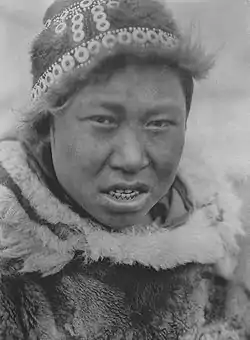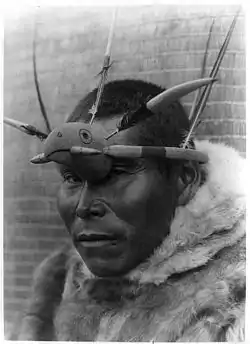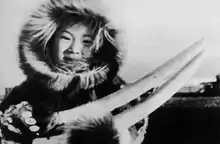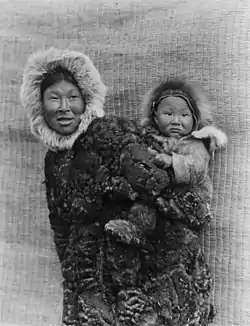Yupik peoples
The Yupik (/ˈjuːpɪk/; Russian: Юпикские народы) are a group of indigenous or aboriginal peoples of western, southwestern, and southcentral Alaska and the Russian Far East. They are related to the Inuit and Iñupiat peoples. Yupik peoples include the following:
- Alutiiq people, or Sugpiaq, of the Alaska Peninsula and coastal and island areas of southcentral Alaska
- Central Alaskan Yup'ik people (alternatively Yup'ik people) of the Yukon-Kuskokwim Delta, the Kuskokwim River, and along the northern coast of Bristol Bay as far east as Nushagak Bay and the northern Alaska Peninsula at Naknek River and Egegik Bay in Alaska
- Siberian Yupik people, including Naukan, Chaplino,[2] and Sirenik of the Russian Far East and St. Lawrence Island[3] in western Alaska
| Total population | |
|---|---|
| ~35,567 | |
| Regions with significant populations | |
| United States Alaska | 33,889[1] |
| Russia Chukotka | ~1,700 |
| Languages | |
| English (Alaska) • Russian (in Siberia) • Yupik languages | |
| Religion | |
| Christianity (mostly Eastern Orthodox and Moravian), Shamanism, Atheism | |
| Related ethnic groups | |
| Aleut, Inuit, Iñupiat, Sirenik | |



Population
The Central Alaskan Yup'ik people are by far the most numerous of the various Alaska Native groups. They speak the Central Alaskan Yup'ik language, a member of the Eskimo–Aleut family of languages.
As of the 2002 U.S. Census, the Yupik population in the United States numbered more than 24,000,[4] of whom more than 22,000 lived in Alaska, the vast majority in the seventy or so communities in the traditional Yup'ik territory of western and southwestern Alaska.[5] U.S. census data for Yupik include 2,355 Sugpiaq; there are also 1,700 Yupik living in Russia.[6]
Etymology of name
Yup'ik (plural Yupiit) comes from the Yup'ik word yuk meaning "person" plus the post-base -pik meaning "real" or "genuine". Thus, it literally means "real people."[7] The ethnographic literature sometimes refers to the Yup'ik people or their language as Yuk or Yuit. In the Hooper Bay-Chevak and Nunivak dialects of Yup'ik, both the language and the people are known as Cup'ik.[8]
The use of an apostrophe in the name "Yup’ik", compared to Siberian "Yupik", exemplifies the Central Alaskan Yup’ik's orthography, where "the apostrophe represents gemination [or lengthening] of the ‘p’ sound".[9]
The "person/people" (human being) in the Eskimo (Yupik and Inuit) languages:
| Eskimo languages | singular | dual | plural |
|---|---|---|---|
| Yupik languages | |||
| Sirenik | йух | (none) | йугый |
| Siberian Yupik | yuk | ? | yuit |
| Naukan | yuk | ? | yuget |
| Central Alaskan Yup’ik | yuk | yuuk | yuut (< yuuget) |
| Chevak Cup’ik | cuk | cuugek | cuuget |
| Nunivak Cup’ig | cug | cuug | cuuget |
| Alutiiq or Sugpiaq | suk | suuk | suuget |
| Inuit languages | |||
| Iñupiaq or Alaskan Inuit | iñuk | iññuk | iñuit / iñuich |
| Inuvialuk or Western Canadian Inuit | inuk | innuk | inuit |
| Inuktitut or Eastern Canadian Inuit | inuk | inuuk | inuit |
| Greenlandic or Kalaallisut | inuk | (none) | inuit |
Origins
The common ancestors of the Eskimo and Aleut (as well as various Paleo-Siberian groups) are believed by anthropologists to have their origin in eastern Siberia, arriving in the Bering Sea area approximately 10,000 years ago.[10] Research on blood types, confirmed by later linguistic and DNA findings, suggests that the ancestors of other indigenous peoples of the Americas reached North America before the ancestors of the Eskimo and Aleut. There appear to have been several waves of migration from Siberia to the Americas by way of the Bering land bridge,[11] which became exposed between 20,000 and 8,000 years ago during periods of glaciation. By about 3,000 years ago, the progenitors of the Yupiit had settled along the coastal areas of what would become western Alaska, with migrations up the coastal rivers—notably the Yukon and Kuskokwim—around 1400 AD, eventually reaching as far upriver as Paimiut on the Yukon and Crow Village on the Kuskokwim.[7]
The Siberian Yupik may represent a back-migration of the Eskimo people to Siberia from Alaska.[12]
Culture

.jpg.webp)
Traditionally, families spent the spring and summer at fish camp, then joined with others at village sites for the winter. Many families still harvest the traditional subsistence resources, especially Pacific salmon and seal.
The men's communal house, the qasgiq, was the community center for ceremonies and festivals that included singing, dancing, and storytelling. The qasgiq was used mainly during the winter months, because people would travel in family groups following food sources throughout the spring, summer, and fall months. Aside from ceremonies and festivals, the qasgiq was also where the men taught the young boys survival and hunting skills, as well as other life lessons. The young boys were also taught how to make tools and qayaqs (kayaks) during the winter months in the qasgiq. The ceremonies involve a shaman.
The women's house, the ena, was traditionally right next door. In some areas the two communal houses were connected by a tunnel. Women taught the young girls how to tan hides and sew, process and cook game and fish, and weave. Boys would live with their mothers until they were approximately five years old, then they would join the men in the qasgiq.
For a period varying between three and six weeks, the boys and girls would switch cultural educational situations, with the men teaching the girls survival, hunting skills, and toolmaking, and the women teaching the boys the skills they taught to the girls.
In Yup'ik group dances, individuals often remain stationary while moving their upper body and arms rhythmically, their gestures accentuated by handheld dance fans, very similar in design to Cherokee dance fans. The limited motion by no means limits the expressiveness of the dances, which can be gracefully flowing, bursting with energy, or wryly humorous.
The Yup'ik are unique among native peoples of the Americas in that they name children after the most recent person in the community to have died.
The kuspuk (qaspeq) is a traditional Yup'ik garment worn by both genders. In Alaska, it is worn in both casual and formal settings.
The seal-oil lamp (naniq) was an important piece of furniture.[13]
Languages
Five Yupik languages (related to Inuktitut) are still very widely spoken; more than 75% of the Yupik/Yup'ik population are fluent in the language.
Like the Alaskan Inupiat, the Alaskan and Siberian Yupik adopted the system of writing developed by Moravian Church missionaries during the 1760s in Greenland. The Alaskan Yupik and Inupiat are the only Northern indigenous peoples to have developed their own system of picture writing, but this system died with its creators.[14] Late nineteenth-century Moravian missionaries to the Yupik in southwestern Alaska used Yupik in church services, and translated the scriptures into the people's language.[15]
Russian explorers in the 1800s erroneously identified the Yupik people bordering the territory of the somewhat unrelated Aleut as also Aleut, or Alutiiq, in Yupik. By tradition, this term has remained in use, as well as Sugpiaq, both of which refer to the Yupik of South Central Alaska and Kodiak.
The whole Eskimo–Aleut language family [8] is shown below (as a wikified version):

Notes
- "The American Indian and Alaska Native Population: 2010" (PDF). Census.gov. US Census Bureau. Retrieved 8 July 2017.
- Achirgina-Arsiak, Tatiana. "Northeastern Siberian: Yupik (Asiatic Eskimo)." Alaska Native Collections. 1996. Retrieved 20 July 2012.
- Video about Yupik communities on St. Lawrence Island, Bering Sea
- U.S. Census Bureau. (2004-06-30). "Table 1. American Indian and Alaska Native Alone and Alone or in Combination Population by Tribe for the United States: 2000." American Indian and Alaska Native Tribes for the United States, Regions, Divisions, and States (PHC-T-18). U.S. Census Bureau, Census 2000, special tabulation. Retrieved on 2007-04-12.
- U.S. Census Bureau. (2004-06-30). "Table 16. American Indian and Alaska Native Alone and Alone or in Combination Population by Tribe for Alaska: 2000." American Indian and Alaska Native Tribes for the United States, Regions, Divisions, and States (PHC-T-18). U.S. Census Bureau, Census 2000, special tabulation. Retrieved on 2007-04-12.
- "Yup’ik." U*X*L Encyclopedia of Native American Tribes. U*X*L. 2008. Retrieved August 14, 2012 from HighBeam Research: http://www.highbeam.com/doc/1G2-3048800051.html
- Fienup-Riordan, 1993, p. 10.
- Alaska Native Language Center Archived January 23, 2009, at the Wayback Machine
- Jacobson, Steven A. Central Yup’ik and the Schools: A Handbook for Teachers. Juneau: Alaska Native Language Center, 1984. page 5
- Naske and Slotnick, 1987, p. 18.
- Naske and Slotnick, 1987, pp. 9–10.
- "New Light on first peopling of the Americas (summer 2015)," Popular Archaeology,http://popular-archaeology.com/issue/summer-2015/article/new-light-on-first-peopling-of-the-americas, accessed 10 Mar 2017
- National Museum of the American Indian : Yup'ik (Yupik Eskimo) Lamps
- "The Inuktitut Language" in Project Naming, the identification of Inuit portrayed in photographic collections at Library and Archives Canada
- Ballard, Jan. "In the Steps of Gelelemend: John Henry Killbuck" Archived 2007-08-15 at the Wayback Machine, Jacobsburg Record (Publication of the Jacobsburg Historical Society, Nazareth, Pennsylvania), Volume 33, Issue 1 (Winter 2006): 4-5, accessed 6 December 2011
- johnson, rick (2019). "yupik people". 1. 12: 120.
- Eskimo-Aleut." Ethnologue. Retrieved 21 July 2012.
- boleware, johnice (2019). "yupik people". 1.
Further reading
- Barker, James H. (1993). Always Getting Ready — Upterrlainarluta: Yup'ik Eskimo Subsistence in Southwest Alaska. Seattle, Washington: University of Washington Press.
- Branson, John and Tim Troll, eds. (2006). Our Story: Readings from Southwest Alaska — An Anthology. Anchorage, Alaska: Alaska Natural History Association.
- Federal Field Committee for Development Planning in Alaska. (1968). Alaska Natives & The Land. Washington, D.C.: U.S. Government Printing Office.
- Campbell, Lyle. (1997). American Indian languages: The historical linguistics of Native America. New York: Oxford University Press. ISBN 0-19-509427-1.
- Fienup-Riordan, Ann. (1983). The Nelson Island Eskimo: Social Structure and Ritual Distribution. Anchorage, Alaska: Alaska Pacific University Press.
- Fienup-Riordan, Ann. (1990). Eskimo Essays: Yup'ik Lives and How We See Them. New Brunswick, New Jersey: Rutgers University Press.
- Fienup-Riordan, Ann. (1991). The Real People and the Children of Thunder: The Yup'ik Eskimo Encounter With Moravian Missionaries John and Edith Kilbuck. Norman, Oklahoma: University of Oklahoma Press.
- Fienup-Riordan, Ann. (1994). Boundaries and Passages: Rule and Ritual in Yup'ik Eskimo Oral Tradition. Norman, Oklahoma: University of Oklahoma Press.
- Fienup-Riordan, Ann. (1996). The Living Tradition of Yup'ik Masks: Agayuliyararput (Our Way of Making Prayer). Seattle, Washington: University of Washington Press.
- Fienup-Riordan, Ann. (2000). Hunting Tradition in a Changing World: Yup'ik Lives in Alaska Today. New Brunswick, New Jersey: Rutgers University Press.
- Fienup-Riordan, Ann. (2001). What's in a Name? Becoming a Real Person in a Yup'ik Community. University of Nebraska Press.
- Jacobson, Steven A., compiler. (1984). Yup'ik Eskimo Dictionary. Fairbanks, Alaska: Alaska Native Language Center, University of Alaska Fairbanks.
- Jacobson, Steven A. "Central Yup’ik and the Schools: A Handbook for Teachers". Juneau: Alaska Native Language Center, 1984.
- Kizzia, Tom. (1991). The Wake of the Unseen Object: Among the Native Cultures of Bush Alaska. New York: Henry Holt and Company.
- MacLean, Edna Ahgeak. “Culture and Change for Iñupiat and Yupiks of Alaska.” 2004. Alaska. 12 Nov 2008
- Mithun, Marianne. (1999). The languages of Native North America. Cambridge: Cambridge University Press. ISBN 0-521-23228-7 (hbk); ISBN 0-521-29875-X.
- Morgan, Lael, ed. (1979). Alaska's Native People. Alaska Geographic 6(3). Alaska Geographic Society.
- Naske, Claus-M. and Herman E. Slotnick. (1987). Alaska: A History of the 49th State, 2nd edition. Norman, Oklahoma: University of Oklahoma Press.
- Oswalt, Wendell H. (1967). Alaskan Eskimos. Scranton, Pennsylvania: Chandler Publishing Company.
- Oswalt, Wendell H. (1990). Bashful No Longer: An Alaskan Eskimo Ethnohistory, 1778–1988. Norman, Oklahoma: University of Oklahoma Press.
- Pete, Mary. (1993). "Coming to Terms." In Barker, 1993, pp. 8–10.
- Reed, Irene, et al. Yup’ik Eskimo Grammar. Alaska: University of Alaska, 1977.
- de Reuse, Willem J. (1994). Siberian Yupik Eskimo: The language and its contacts with Chukchi. Studies in indigenous languages of the Americas. Salt Lake City: University of Utah Press. ISBN 0-87480-397-7.
External links
- Alaska Native Language Center
- Genealogical tree
- The distribution map of Yupik languages.
- Project Naming, the identification of Inuit portrayed in photographic collections at Library and Archives Canada
